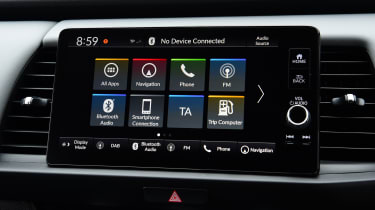Honda Jazz - Interior, design and technology
A smart interior and plenty of on-board tech should allow the Honda Jazz to attract more customers

With the roofline reduced by 10mm, the Honda Jazz has a sleeker silhouette than before, although the overall profile is still more like that of a small MPV, rather than a supermini. Slimmer A-pillars also help with forward visibility and add to the already good-sized glasshouse.
Honda has opted to do away with the vibrant paint choices offered for the previous Jazz model. Instead, there’s a rather dull choice of pearlescent and metallic colours to choose from, although Honda does include optional ‘Fun’ packs, which allow the opportunity to add further personalisation to the exterior. The packs include different coloured trim pieces for the front grille and rear bumper, side body mouldings, and door mirror caps.
Inside, the four-generation Jazz has a definite whiff of the Honda e in its cabin, which is no bad thing. It’s a much classier look, with a minimalist two-spoke steering wheel, a seven-inch digital driver display, and a nine-inch central touchscreen. The dash is clearly laid out, with large physical switches and dials for the ventilation functions positioned underneath the touchscreen. It’s certainly a pleasant place to sit, although the Peugeot 208 still claims the crown for overall quality.
Sat-nav, stereo and infotainment
Every Jazz is equipped with a nine-inch touchscreen and Honda Connect infotainment system. While the screen uses big widgets that link to the prime functions, performing tasks such as changing radio stations or entering an address requires more steps than you might expect, so it’s not the easiest system to navigate around.
Most functions are operated via the touchscreen, but the main menu and back buttons are physical controls next to the screen above a volume knob. The buttons take a bit of getting used to, but once you’re in the habit, it makes life easier to get back to the main menu.
Wireless Apple CarPlay is included, but Android Auto requires a cable connection. There’s no charging pad, so iPhone users will also have to plug their devices in to keep them charged.










